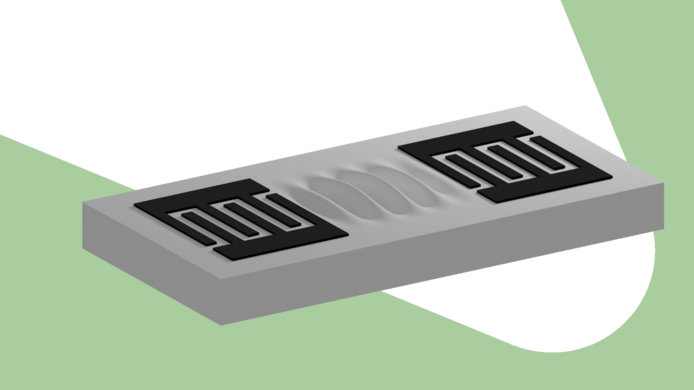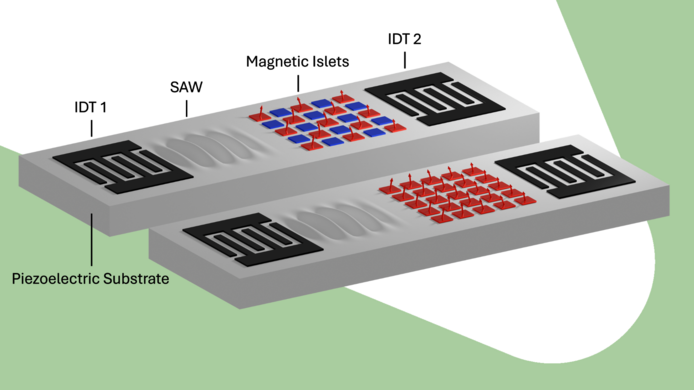The wave converter

Every smartphone includes a myriad of sophisticated technologies, many of which use electromagnetic waves that oscillate back and forth between millions and billions of times per second. It is these waves that enable the device to communicate with cell towers, Wi-Fi, and other devices.
Modern smartphones contain around a hundred elements that filter and manipulate these waves. These filters often consist of components that convert alternating current into mechanical waves, filter these waves by means of their mechanical properties, and then convert them back into electricity.
At the University of Vienna, Claas Abert is conducting research on these filters in the context of the FWF-funded project “Programmable integrated magneto-phononic circuits” together with an international team from Augsburg and Münster. Abert is a senior scientist at the University of Vienna and a member of the MMM – Mathematics-Magnetism-Materials research platform.
It is Abert’s objective to make these components – which are typically static and thus only able to filter a specific frequency range – programmable and thus more versatile. For this purpose, Abert is exploiting the complex interactions between mechanical waves and the magnetic properties of the components. Such a programmable filter could then take over the function of several static filters, thereby saving space in the smartphone and reducing production costs.
About the project
The growing demand for data storage and faster transmission rates in wireless telecommunications is placing increasing demands on hardware. The spin wave technology being developed in this international research project offers promising solutions.

Translation between electrical and acoustic
In order to understand the research conducted by Abert and his colleagues, it helps to know some basic facts about these frequency filters. The frequency filters in smartphones are only a few millimeters in size and basically consist of three components: two interdigital transducers and the substrate between them.
An interdigital transducer is a flat structure consisting of two interlocking combs made of conductive material to which an alternating voltage is applied. As the two combs do not touch, there is no current flow between them. However, they generate an electric field that oscillates back and forth with the alternating current. The material of the substrate under the interdigital transducer is piezoelectric, meaning that it changes shape when exposed to an electric field.
So the alternating current in the combs of the interdigital transducer generates alternating electric fields, which in turn change the shape of the substrate below at the same frequency. This generates mechanical waves in the substrate material, which propagate on its surface. These are the surface acoustic waves –“SAW” for short – the researchers use for their work.
These SAWs propagate on the substrate surface and reach a second interdigital transducer, where the interaction is reversed. The piezoelectric substrate generates electric fields by compressing and stretching the wave. These fields are picked up by the combs of the interdigital transducer and converted into electric current.
But why is it necessary to go through this conversion from electrical to mechanical waves and back again? “These filter components are usually designed so as to permit SAWs with specific frequencies to pass through while they attenuate others,” explains Abert. “This is a very effective way to filter frequencies using small, inexpensive, and reliable components. It is our goal to make these components programmable and thus more versatile.”
Having the right spin
“Waves – which means regular changes in certain properties that propagate through space and time – are everywhere,” says Abert. “There are mechanical waves in the air or in solids, for instance, there are electromagnetic waves, and even spin waves. This filter already uses the two former types of waves, and we now want to incorporate the third one as well.”
Spin is a quantum mechanical property of individual particles or atoms. One can compare it to the properties of a particle spinning around its own axis, which is where the name is derived from. The spin of the particles in a material is also responsible for its magnetic properties.
The quantum mechanical properties of spin lead to complex behavior when there is interaction between the spins of individual atoms. When, for instance, the spin of a particle changes, this also leads to changes in the spin of neighboring atoms, which in turn changes the spin of their neighbors. This change propagates through the material in a wave, a so-called spin wave.
“Waves have the special feature that you can couple totally different types of waves if they have the same frequency and wavelength,” explains Abert. “In this way, it is prossible for different systems to communicate that would otherwise interact very little with each other – such as surface waves and spin waves. That's the knack underlying our project.”

Programmable filter
It is anything but easy to achieve this coupling of mechanical and spin waves. “We have to incorporate a large number of tiny regions into the substrate material of the filter in which we can precisely control the spin and thus their magnetic properties,” explains Abert. The individual regions must be very close to each other – but not touch – so as to be able to interact effectively. Abert adds: “We are talking about margins in the nanometer range – millionths of a millimeter, in other words.”
By controlling these spin regions in the substrate material, the researchers can adjust the behavior of the spin waves and determine their preferred oscillation frequency with precision. When they set these parameters so that the frequency and wavelength of the spin waves match the properties of the surface acoustic waves in the substrate, something remarkable happens: the waves moving on the surface of the substrate transfer their energy to the spin waves. This makes them weaker and less able to cause the interdigital transducer at the other end of the substrate to oscillate, hence the transducer generates less current. In other words, they are filtered out.
A single component replaces several filters
Abert notes: “The great thing about this is that we can control the spin regions, meaning we can also control the filtered frequency. As a result, we no longer need an individual fixed filter for each frequency, but can work with a single component that replaces several such filters.”
It must be said that this technology is still years away from practical application. “Under the lead of my colleagues Michael Steinbauer and Peter Flauger, we recently simulated the workings of these programmable filters,” says Abert. “Our colleagues in Münster and Augsburg are now working on testing these ideas at the experimental level.”
With a view to future applications, Abert adds: “The obvious application is in smartphones and other electronics that operate at similar frequencies and need to filter them. But you could also look at it from the opposite angle. Instead of filtering mechanical waves using spin waves, you could use mechanical waves to introduce new functions into magnetic systems based on spin waves. But that would be a different research project.”
About the researcher
Claas Abert is a senior scientist at the University of Vienna and a member of the MMM – Mathematics-Magnetism-Materials research platform. He obtained his doctorate with a thesis on discrete mathematical concepts for micromagnetic simulations at the University of Hamburg, holds a venia docendi in physics from the University of Vienna, and is the author and lead developer of various programs for micromagnetic simulations, including the finite element software magnum.fe. His research ranges from numerical algorithms to the application of these methods to magnetic and spintronic systems such as magnetoresistive sensors and spin-torque MRAM. Abert has lectured on computational physics and currently teaches micromagnetics and spintronics at the University of Vienna.
Publications
Magnetically Programmable Surfache Acoustic Wave Filters: Device Concept and Predictive Modeling, arXiv 2025
Micromagnetic simulation and optimization of spin-wave transducers | Scientific Reports, 2025
Inverse-design topology optimization of magnonic devices using level-set method | npj Spintronics, 2025






